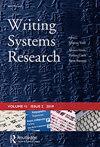The effect of the internal orthographic connectivity of written Arabic words on the process of the visual recognition: A comparison between skilled and dyslexic readers
Q1 Arts and Humanities
引用次数: 23
Abstract
Previous research has suggested that reading Arabic is more challenging than reading Hebrew or English, even among native Arabic readers due to the visual complexity of the Arabic orthography. In particular, the fact that most of the Arabic letters connect to each other and change their basic form according to their place in the written word (beginning, middle or end) has been hypothesised to constitute a visual load affecting reading efficiency. Here, we tested this visual complexity hypothesis by manipulating word-internal orthographic connectivity during visual word recognition. Fifty-eight adult skilled readers and 20 disabled readers of Arabic performed a lexical-decision task using words (and nonwords) whose letters were naturally fully connected (Cw), partially connected (PCw) and nonconnected (NCw). Behavioural measures for words as a function of word connectivity (and word frequency) were analysed using repeated measures analysis of variance. The results revealed that within both groups of readers, higher accuracy rates were measured for the Cw rather than for the NCw, with PCw falling in between. The analysis of the individual standard deviations of the response times within each word condition revealed that Cw yielded a response variance lower than NCw, again with PCw in between. These results indicate that Cw tend to be processed more efficiently and accurately than NCw, in both reader groups. The results presented here extend recent findings in normal readers and indicate that word connectivity does not negatively impact word recognition processes among adults. The psycholinguistic and neurolinguistic implications of these findings are discussed.阿拉伯文文字内部正字法连通性对视觉识别过程的影响:熟练阅读者与诵读困难阅读者之比较
先前的研究表明,阅读阿拉伯语比阅读希伯来语或英语更具挑战性,甚至对母语为阿拉伯语的读者来说也是如此,因为阿拉伯语正字法的视觉复杂性。特别是,大多数阿拉伯字母相互连接,并根据其在书面单词中的位置(开头、中间或结尾)改变其基本形式,这一事实已被假设构成影响阅读效率的视觉负荷。在这里,我们通过在视觉单词识别过程中操纵单词内部的正字法连接来测试视觉复杂性假设。58名成年熟练读者和20名残疾阿拉伯语读者使用字母自然完全连接(Cw)、部分连接(PCw)和非连接(NCw)的单词(和非单词)进行词汇决策任务。作为单词连通性(和词频)功能的单词行为测量使用重复测量方差分析进行了分析。结果显示,在两组读者中,Cw的准确率高于NCw, PCw介于两者之间。对每个单词条件下反应时间的个体标准差的分析显示,Cw产生的反应方差低于NCw, PCw介于两者之间。这些结果表明,在两组阅读者中,连续语往往比非连续语更有效和准确地被处理。本文提出的结果扩展了最近在正常读者中的发现,并表明单词连接对成年人的单词识别过程没有负面影响。讨论了这些发现的心理语言学和神经语言学意义。
本文章由计算机程序翻译,如有差异,请以英文原文为准。
求助全文
约1分钟内获得全文
求助全文

 求助内容:
求助内容: 应助结果提醒方式:
应助结果提醒方式:


